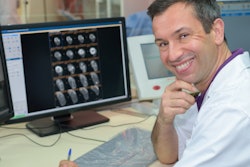VIENNA - There are not enough secondary evidence-based radiology research studies conducted by radiology professionals -- a shortfall that could negatively impact the specialty's clinical role, according to a Saturday session at the European Congress of Radiology (ECR).
In a series of presentations in a European Network for the Assessment of Imaging in Medicine (EuroAIM) session sponsored by the European Institute for Biomedical Imaging Research (EIBIR), researchers shared their findings -- and possible solutions -- regarding the relative paucity of secondary studies evaluating imaging. These secondary studies include systematic reviews/meta-analyses, cost-effective analyses, guidelines, and position papers.
There are a number of reasons for the delays in applying evidence-based medicine to radiology, including the rapid pace of technology development, said Dr. Francesco Sardanelli, from the University of Milan in Italy.
"It's not so easy to apply the principle of evidence-based radiology when the technology evolves so rapidly," he said.
Sardanelli also shared preliminary findings from a EuroAIM research effort to determine the role of radiologists in the authorship of secondary studies involving imaging. While fewer than 10% of the selected abstracts have been evaluated to date, 100 (or 72% of those being examined so far) have no radiologists or nuclear medicine specialists as authors, Sardanelli said.
In the future, EuroAIM will analyze whether the low number of radiological secondary studies is due to the lack of primary studies, or just to the lack of systematic reviews and meta-analyses of existing primary studies. They will also identify priorities for performing primary and secondary studies in lacking areas, and organize the group for this task, Sardanelli said.
Diagnostic imaging
In the second talk of the session, Dr. Luca Sconfienza, also from the University of Milan, shared EuroAIM research specifically evaluating diagnostic imaging procedures, -- including image-guided needle biopsy procedures. A EuroAIM Evidence-Based Radiology (EBR) working group used 12 terms identifying imaging modalities to search the PubMed and EMBASE databases to gather relevant secondary studies from January 2000 to May 2010.
After 2,944 abstracts were initially found and evaluated, 1,245 papers (an average of 120.5 per year) were included following exclusion of congress abstracts, nonsecondary studies, and nonimaging-related research.
Breakdown of imaging-related secondary research
- Diagnostic imaging procedures performed by radiologists/nuclear medicine specialists: 808 (64.9%)
- Diagnostic imaging procedures performed by non-radiology/nuclear medicine specialists: 244 (19.6%)
- Effect of treatment using a diagnostic imaging procedure as an end point: 193 (15.5%)
Mean annual publication volume of diagnostic imaging procedures papers
- Performed by radiology/nuclear medicine specialists: 78.1
- Evaluating a treatment using diagnostic imaging procedure as an end point: 18.9
- Performed by non-radiology/nuclear medicine specialists: 23.5
Mean annual publication volume by specialty
|
In other research findings, Sconfienza noted that while the highest-ranked imaging journals keep the traditional four-block abstract structure, 13 nonimaging journals require more information using additional mandatory abstract blocks.
"Imaging journals should consider this possibility in order to make evidence-based medicine criteria easier to apply," he said.
Increased development of evidence-based radiology would offer a competitive advantage with other specialties, Sconfienza said.
"It will be a huge way for us to compete with other specialists that otherwise would perform their meta-analysis, involving standards and methods that we use," he said.
Interventional radiology
The shortage of secondary evidence is also present in interventional radiology, according to Dr. Dierk Vorwerk, of Klinikum Ingolstadt in Ingolstadt, Germany.
This is influenced in part by the lack of primary studies in interventional radiology, Vorwerk said.
"There are [also] many competing specialties, and they are much more experienced in producing primary evidence and secondary evidence," he said. "And there is a United States domination in the industry in interventional radiology, and therefore, many of the studies in interventional radiology come from the U.S."
And since most of the interventional procedures are performed in the U.S., a lot of nonradiologists will be involved in primary and secondary evidence studies, Vorwerk said.
The EuroAIM group also searched PubMed and EMBASE using 12 terms identifying imaging modalities to retrieve secondary studies on image-guided interventional therapeutic procedures published between January 2000 and May 2010.
Of the 1902 abstracts initially found, 203 remained after congress abstracts, nonsecondary studies, nonimaging-related studies, secondary studies concerning diagnostic imaging procedures, and those covering image-guided needle biopsy procedures were excluded.
Image-guided interventional therapeutic procedures performed by radiologists made up 45 (22%) of the studies, while 158 (78%) included studies performed by nonradiologists.
Mean number of studies per year by body district
|
To gain more secondary evidence studies, the creation of primary evidence studies also need to be stimulated, Vorwerk said.
"And we have to select and find those areas that are crucial for interventional radiology," he said.
An American model?
In the quest to develop more secondary studies, the American College of Radiology Imaging Network (ACRIN) might be a good example to follow, Sardanelli said.
In the final talk of the session, ACRIN-founding principal investigator Dr. Bruce Hillman, provided an overview and update on ACRIN, which has conducted more than 40 imaging trials since its inception in 1999. Noted achievements include a number of landmark studies, including the Digital Mammographic Imaging Screening Trial (DMIST), National CT Colonography Trial (NCTCT), and the currently active National Lung Screening Trial (NLST).
There are a few opportunities for Europeans to collaborate with ACRIN, including promoting institutional participation in ACRIN trials, Hillman said.
In addition, researchers could outsource infrastructure to ACRIN and lead ACRIN trials, he said.











